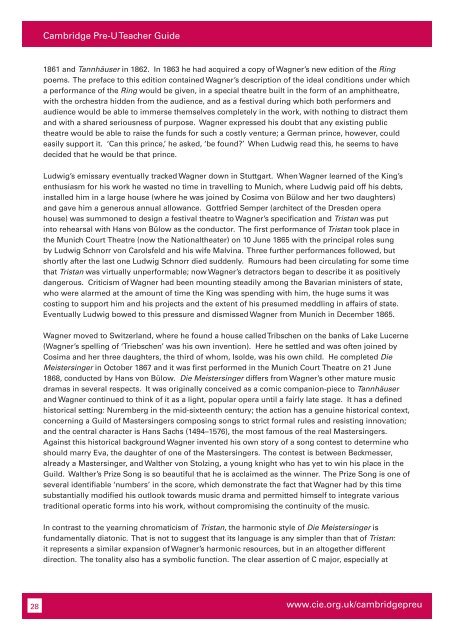Teacher's Guide Cambridge Pre-U MUSIC Available for teaching ...
Teacher's Guide Cambridge Pre-U MUSIC Available for teaching ...
Teacher's Guide Cambridge Pre-U MUSIC Available for teaching ...
Create successful ePaper yourself
Turn your PDF publications into a flip-book with our unique Google optimized e-Paper software.
28<br />
<strong>Cambridge</strong> <strong>Pre</strong>-U Teacher <strong>Guide</strong><br />
1861 and Tannhäuser in 1862. In 1863 he had acquired a copy of Wagner’s new edition of the Ring<br />
poems. The preface to this edition contained Wagner’s description of the ideal conditions under which<br />
a per<strong>for</strong>mance of the Ring would be given, in a special theatre built in the <strong>for</strong>m of an amphitheatre,<br />
with the orchestra hidden from the audience, and as a festival during which both per<strong>for</strong>mers and<br />
audience would be able to immerse themselves completely in the work, with nothing to distract them<br />
and with a shared seriousness of purpose. Wagner expressed his doubt that any existing public<br />
theatre would be able to raise the funds <strong>for</strong> such a costly venture; a German prince, however, could<br />
easily support it. ‘Can this prince,’ he asked, ‘be found?’ When Ludwig read this, he seems to have<br />
decided that he would be that prince.<br />
Ludwig’s emissary eventually tracked Wagner down in Stuttgart. When Wagner learned of the King’s<br />
enthusiasm <strong>for</strong> his work he wasted no time in travelling to Munich, where Ludwig paid off his debts,<br />
installed him in a large house (where he was joined by Cosima von Bülow and her two daughters)<br />
and gave him a generous annual allowance. Gottfried Semper (architect of the Dresden opera<br />
house) was summoned to design a festival theatre to Wagner’s specification and Tristan was put<br />
into rehearsal with Hans von Bülow as the conductor. The first per<strong>for</strong>mance of Tristan took place in<br />
the Munich Court Theatre (now the Nationaltheater) on 10 June 1865 with the principal roles sung<br />
by Ludwig Schnorr von Carolsfeld and his wife Malvina. Three further per<strong>for</strong>mances followed, but<br />
shortly after the last one Ludwig Schnorr died suddenly. Rumours had been circulating <strong>for</strong> some time<br />
that Tristan was virtually unper<strong>for</strong>mable; now Wagner’s detractors began to describe it as positively<br />
dangerous. Criticism of Wagner had been mounting steadily among the Bavarian ministers of state,<br />
who were alarmed at the amount of time the King was spending with him, the huge sums it was<br />
costing to support him and his projects and the extent of his presumed meddling in affairs of state.<br />
Eventually Ludwig bowed to this pressure and dismissed Wagner from Munich in December 1865.<br />
Wagner moved to Switzerland, where he found a house called Tribschen on the banks of Lake Lucerne<br />
(Wagner’s spelling of ‘Triebschen’ was his own invention). Here he settled and was often joined by<br />
Cosima and her three daughters, the third of whom, Isolde, was his own child. He completed Die<br />
Meistersinger in October 1867 and it was first per<strong>for</strong>med in the Munich Court Theatre on 21 June<br />
1868, conducted by Hans von Bülow. Die Meistersinger differs from Wagner’s other mature music<br />
dramas in several respects. It was originally conceived as a comic companion-piece to Tannhäuser<br />
and Wagner continued to think of it as a light, popular opera until a fairly late stage. It has a defined<br />
historical setting: Nuremberg in the mid-sixteenth century; the action has a genuine historical context,<br />
concerning a Guild of Mastersingers composing songs to strict <strong>for</strong>mal rules and resisting innovation;<br />
and the central character is Hans Sachs (1494–1576), the most famous of the real Mastersingers.<br />
Against this historical background Wagner invented his own story of a song contest to determine who<br />
should marry Eva, the daughter of one of the Mastersingers. The contest is between Beckmesser,<br />
already a Mastersinger, and Walther von Stolzing, a young knight who has yet to win his place in the<br />
Guild. Walther’s Prize Song is so beautiful that he is acclaimed as the winner. The Prize Song is one of<br />
several identifiable ‘numbers’ in the score, which demonstrate the fact that Wagner had by this time<br />
substantially modified his outlook towards music drama and permitted himself to integrate various<br />
traditional operatic <strong>for</strong>ms into his work, without compromising the continuity of the music.<br />
In contrast to the yearning chromaticism of Tristan, the harmonic style of Die Meistersinger is<br />
fundamentally diatonic. That is not to suggest that its language is any simpler than that of Tristan:<br />
it represents a similar expansion of Wagner’s harmonic resources, but in an altogether different<br />
direction. The tonality also has a symbolic function. The clear assertion of C major, especially at<br />
www.cie.org.uk/cambridgepreu
















